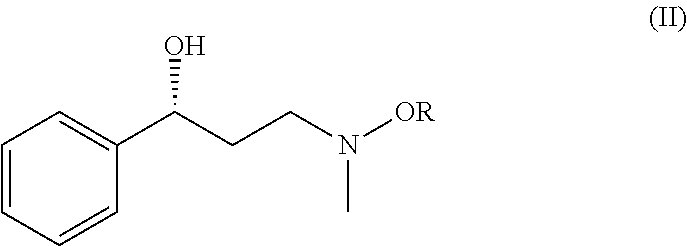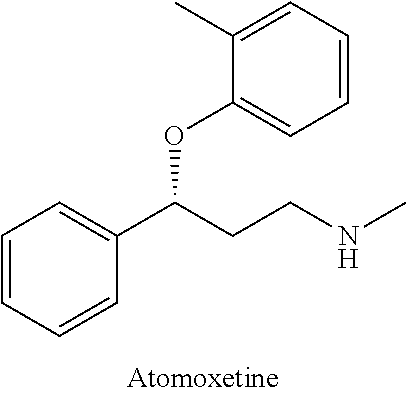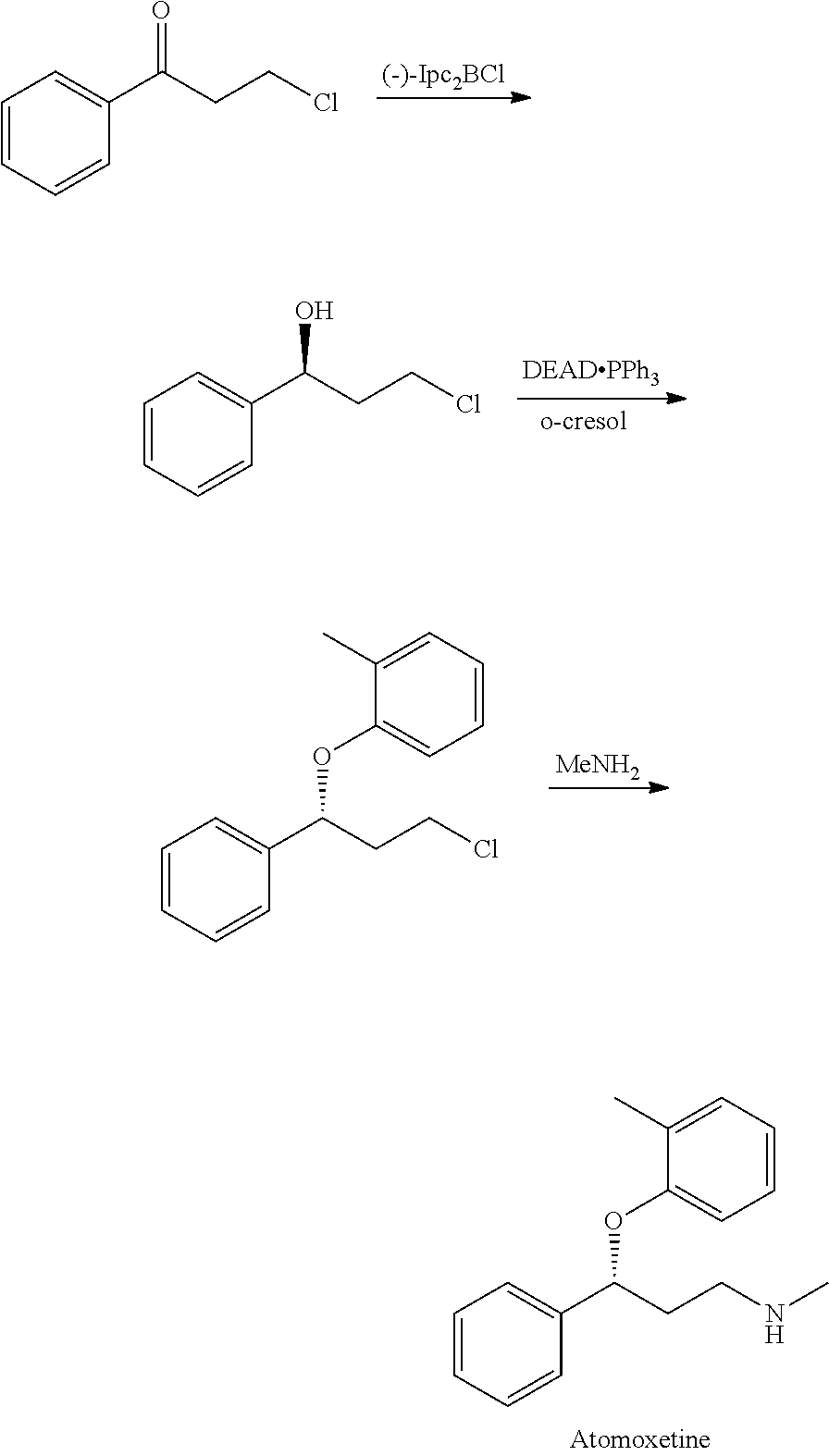Method for preparing atomoxetine
a technology of atomoxetine and atomoxetine, which is applied in the field of preparing atomoxetine, can solve the problems of low economic competitiveness of the process, high manufacturing cost, and inefficiency of the chiral resolution step, and achieve the effect of economic competitiveness and environmental protection
- Summary
- Abstract
- Description
- Claims
- Application Information
AI Technical Summary
Benefits of technology
Problems solved by technology
Method used
Image
Examples
example 1
Synthesis of 3-methoxymethylamino-1-phenyl-1-propanone hydrochloride salt
276.0 g of N,O-dimethylhydroxylamine hydrochloride, 101.3 g of paraformaldehyde, 77.4 g of 32% hydrochloride, 374.1 g of 2-acetylthiophene and 800 g of isopropanol were provided into a flask. After being stirred at 700 for 13 hours, the reaction mixture was cool down to room temperature. The crystal thus formed was filtered, washed with 700 g of isopropanol and dried under reduced pressure to obtain 569.3 g of 3-methoxymethylamino-1-phenyl-1-propanone hydrochloride salt (87.6%). 1H NMR (400 MHz, CDCl3) δ (ppm)=2.6 (s, 3H), 3.1 (t, J=6.8 Hz 2H), 3.2 (t, J=6.8 Hz 2H), 3.5 (s, 3H), 7.4-7.5 (m, 2H), 7.5 (m, 1H), 8.0 (m, 2H).
example 2
Synthesis of (R)-3-methoxymethylamino-1-phenyl-1-propanol
100 mL of degassed methanol solution containing 50 mg of RuCl2—((S)-DMSEGPHOS)((S)-DAIPEN), 47.9 of 3-methoxymethylamino-1-phenyl-1-propanone, and 2.2 g of 30% sodium methoxide methanol solution were provided in a glass autoclave under an argon gas flow. After deaeration and replacement by argon, hydrogen was introduced to a predetermined pressure. The resulting solution was hydrogenated at 20° for 12 hours. Upon completion of hydrogenation, the reaction mixture was concentrated to obtain an objective compound as an oily product (47.8 g, 98.8% by HPLC assay, 99% ee). 1H NMR (400 MHz, CDCl3) δ (ppm)=1.9 (m, 2H), 2.6 (s, 3H), 2.8 (m, 2H), 3.6 (s, 3H), 4.5 (br, 1H), 4.9 (m, 1H), 7.2-7.4 (m, 5H).
example 3
Synthesis of (R)-3-methylamino-1-phenyl-1-propanol
The oily product of (R)-3-methoxymethylamino-1-phenyl-1-propanol obtained in example 2 was dissolved in 100 mL of methanol again with 1.2 g of Raney-nickel in a glass autoclave. The resulting solution was hydrogenated at 50° for 12 hours. Upon completion of hydrogenation, the reaction mixture was filtered and the solvent was removed under reduced pressure to obtain an objective compound as an oily compound (39.0 g, 96.5% by HPLC assay, 99% ee). The crude product was further purified by re-crystallization in toluene and heptane with optical purity as high as 100% ee. 1H NMR (400 MHz, CDCl3) δ (ppm)=1.7-1.8 (m, 1H), 1.8-1.9 (m, 1H), 2.5 (s, 3H), 2.8-2.9 (m, 2H), 4.9 (dd, J=3, 8.6 Hz, 1H), 7.3-7.4 (m, 5H).
PUM
| Property | Measurement | Unit |
|---|---|---|
| optical purity | aaaaa | aaaaa |
| optical active | aaaaa | aaaaa |
| pH | aaaaa | aaaaa |
Abstract
Description
Claims
Application Information
 Login to View More
Login to View More - R&D
- Intellectual Property
- Life Sciences
- Materials
- Tech Scout
- Unparalleled Data Quality
- Higher Quality Content
- 60% Fewer Hallucinations
Browse by: Latest US Patents, China's latest patents, Technical Efficacy Thesaurus, Application Domain, Technology Topic, Popular Technical Reports.
© 2025 PatSnap. All rights reserved.Legal|Privacy policy|Modern Slavery Act Transparency Statement|Sitemap|About US| Contact US: help@patsnap.com



